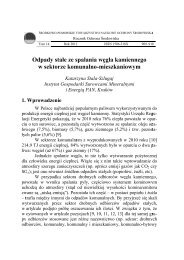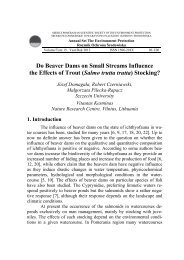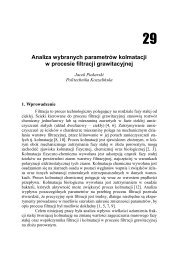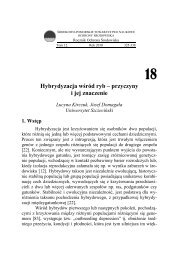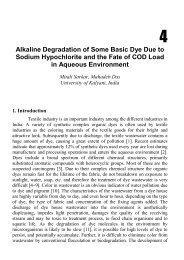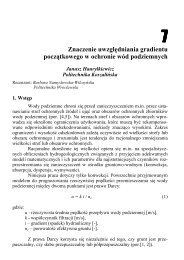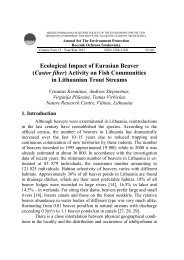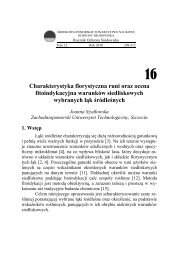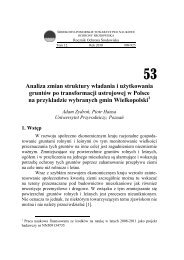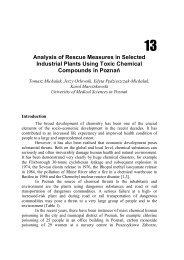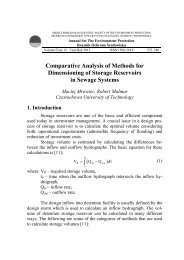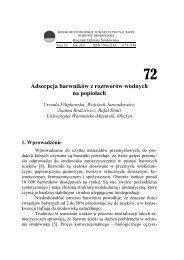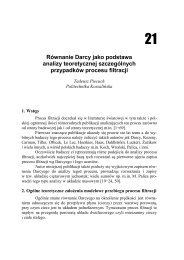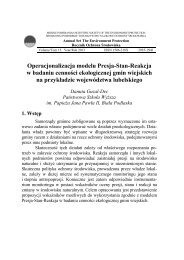Bronisława Sas-Piotrowska, Wojciech Piotrowski
Bronisława Sas-Piotrowska, Wojciech Piotrowski
Bronisława Sas-Piotrowska, Wojciech Piotrowski
You also want an ePaper? Increase the reach of your titles
YUMPU automatically turns print PDFs into web optimized ePapers that Google loves.
<strong>Bronisława</strong> <strong>Sas</strong>-<strong>Piotrowska</strong>, <strong>Wojciech</strong> <strong>Piotrowski</strong><br />
fungi, and as well as by plants. It is known that most of plants produces compounds<br />
with allelochemical, biocidial and biostatical effect (Achremowicz, CieŜ<br />
1992). The biological activity of plant extracts depends however on several factors,<br />
and first of all on content of specific chemical compounds and on their<br />
ability to diffuse. Besides that some those compounds may stimulate a pathogen<br />
development and increase a degree of contamination and the others can act as<br />
inhibition factors (<strong>Sas</strong>-<strong>Piotrowska</strong> and others 1995b, 1996). The impact on protected<br />
plants is also of importance.<br />
The aim of the investigations carried out was a laboratory evaluation of<br />
a fungicidal activity of extracts from polygonaceous plants against Fusarium<br />
oxysporum, root rot agents on Papilionaceae plants.<br />
2. Material and methods<br />
The material used in investigations was as follows :<br />
Polygonaceous plants (Polygonaceae) from which the extracts were prepared,<br />
and namely Polygonum bistorta L., P. hydropiper L., P. convolvulus L., P.<br />
persicaria L., P. aviculare L and P. sachalinense Schmidt. The investigated<br />
in vivo plant extracts were prepared in a form of water extracts (maceration<br />
and infusion) as well as alcohol and acetone solutions. The way of their preparation<br />
was given in earlier studies (<strong>Sas</strong>-<strong>Piotrowska</strong>, <strong>Piotrowski</strong> 1997).<br />
Seeds of following leguminous plants: horse bean (Vicia faba L. ssp. minor),<br />
white lupine (Lupinus albus L.), yellow lupine (Lupinus luteus L.)<br />
Fungus Fusarium oxysporum (Schl.) causing the root rot diseases of leguminous<br />
plants. Its culture was carried out on Petri dishes with a PDA nutrient<br />
medium. From one week old cultures of F. oxysporum overgrowed<br />
with mycelium, agar discs with a diameter of 5 mm were cut and served as<br />
an infection material.<br />
The experimental method was as follows: disinfected and rinsed in a<br />
sterile distilled water seeds were dressed in rotary seed dresser with one of the<br />
mentioned extracts (7 minutes), and then the seeds were left for 20 hours. The<br />
next day the seeds were put in suitably prepared glass tubes, the overgrowed<br />
with fungus mycelium agar discs were put on and all was plugged with a cotton<br />
wool. After 2 weeks of incubation in conditions of natural lighting and ambient<br />
temperature the healthiness and vitality evaluation were made:<br />
as a criterion of healthiness a degree of root infection was taken, and a 9 -<br />
grade scale were applied, where 1 o - lack of infection symptoms , 9 o - dark<br />
browned and dead roots. The analysis of variance was carried out on the according<br />
to Townsend-Heuberger formula transformed values;<br />
as a criterion of vitality a root length in cm and their mass in g were taken.<br />
192<br />
Middle Pomeranian Scientific Society of the Environment Protection



